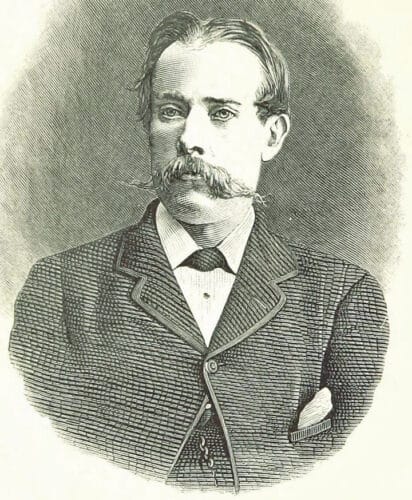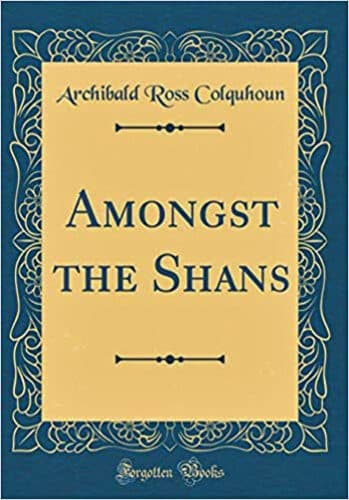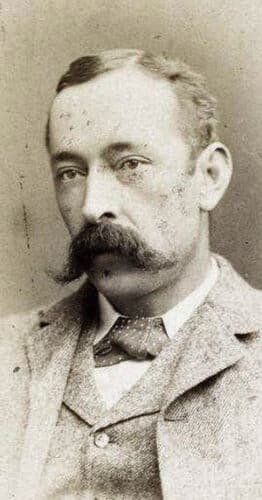Archibald Ross Colquhoun & Chiang Mai

Archibald Ross Colquhoun – Wikipedia
One of the books I cherish in my rather extensive Asian library is the book 'Amongst the Shans' by Archibald Ross Colquhoun. My edition is the 1888 edition - I suspect a first edition - which rolled off the presses at Scribner & Welford in New York and contains Terrien de Lacouperie's 'The Cradle of the Shan Race' as an introduction.
It is an interesting book in more ways than one. Not only because it contains one of the first, fairly reliable European accounts of what is now the north of Thailand, but also because it makes it abundantly clear that the British, like almost all Western superpowers, had a completely different geopolitical interpretation of the then northern principality. Lana then assumed central authority in Bangkok. After all, the book was written in the period when the Siamese king Chulalongkorn, out of an anti-colonial defense reflex, but also simply out of hunger for land, systematically began to annex what he usually regarded as vassal states under the guise of unification, with or without force. the unification of the multi-nation state that was the kingdom of Siam.
He did this in two ways. On the one hand, by limiting the power of the local rulers and systematically replacing them with royal envoys – often his brothers or half-brothers – who, endowed with all kinds of special rights and powers, gradually took over the administration of the region. On the other hand, through a subsequent major administrative-structural reform that in fact amounted to a 'divide & conquer' concept in which these kingdoms were reduced to the rank of provinces (changwat) and divided into districts (amphoe) under the direct control of Bangkok. Ross Colquhoun's book is therefore a precious contemporary or time document that bears witness to a -recent- past that today's current official Thai historiography prefers to remain silent or distort and embellish the facts….

Reprint of Amongst the Shan
Ross Colquhoun was one of those men on whom the British Empire was built. Today he would undoubtedly be very politically correct put in the dark as a dirty colonizer, but that does not alter the fact that he has led a very adventurous life and has seen just about every nook and corner of the world. He was born sometime in March 1848 in Cape Town in the South African Cape Colony. Not much is known about his young years and it is rather a matter of time.
We know that he had Scottish ancestors and was trained as a civil engineer. About 1880 he began to travel the world intensively. For example, he took part in a number of expeditions that, among other things, had to better map Burma, Indochina and South China and, above all, open them up with a view to improving trade relations with Great Britain. These, often very adventurous trips, did not go unnoticed. His journey from Canton to the Irrawadi in Burma earned him the prestigious award in 1884 Founder's Gold Medal of the equally venerable Royal Geographical Society on. This rare award could only be awarded after royal permission, which concretely meant that Queen Victoria may have had a soft spot for this young explorer with the imposing mustache. And that was not entirely unjustified. For in early 1885 Ross Colquhoun paved the way for the full British annexation of Burma by publishing his book with the eloquent title 'Burma and the Burmans or The Best Unopened Market in the World'. A book in which he argued that the only brake on the economic development of Burma for the benefit of the Indian and therefore British market, was the despotic and completely incompetent Burmese king Thibaw.
This publication caused a stir in London and Lord Randolph Churchill (yes, Winston's father), who was the British Secretary of State for India at the time, found this reason, after - completely unfounded - rumors about a possible French attempt to annexation and an equally foggy affair in which a Scottish firm got into serious trouble with corrupt Burmese authorities. The ambitious Churchill was only too happy to accept Ross Colquhoun's suggestion. He ordered General Sir Harry North Dalrymple Prendergast to handcuff Thibaw and crush the ensuing rebellion with all his might. This story did not harm Ross Colquhoun, because in the spring of 1887, perhaps partly due to his expertise in the region, he was appointed as Deputy Commissioner, the second most senior colonial official in Burma.
Ross Colquhoun was, in other words, an author to be reckoned with. This was confirmed again in 1889. In that year he returned to the south of Africa where, from October 1890 to September 1892, he made the first Administrator of Southern Rhodesia became a key figure in local British colonial rule. After his term of office expired, the travel bug struck again and he visited numerous countries in East and West, from the Dutch East Indies to the Philippines and Japan to Siberia, not to mention South America and the United States. His last greatest journey took place in 1913 when he was commissioned by the Royal Colonial Institute of South America, went on to study the construction of the Panama Canal. When he died December 18, 1914, he left behind 12 travel books - some of which are still quite enjoyable - and dozens of articles. His bestseller'China in Transformation' knew no less than 38 reprints. The last one dates from 2010.
His equally wanderlust widow Ethel Maud Cookson remarried and moved to Southern Rhodesia where she was elected a Member of Parliament shortly after World War I: the first ever female Member of Parliament in the Overseas Territories of the British Empire…
Ross Colquhoun, as I have already pointed out, was one of the very first Europeans to write about Chiang Mai. He first arrived in Siam in 1879 when he was secretary of the diplomatic delegation sent by the British government in 1879 to Siam and the Shan states with a view to deepening and expanding diplomatic contacts. After all, the British were apprehensive about the possible expansion of the French sphere of influence in the wider region and wanted to prevent this at all costs. A strange detail was that Ross Colquhoun was not a diplomat at that time, but as an engineer he was part of the colonial administration in India. We know that he was received in audience at least once in Bangkok in 1879 by the Siamese king Chulalongkorn, who was trying to become good friends with the British during that period. Chulalongkorn was apparently very concerned about keeping the British on friendly terms. This was evident, for example, from the fact that he not only facilitated the journey from Ross Colquhoun to Chiang Mai by providing elephants, floats and porters, but also, to the astonishment of British travelers, immediately built a house in Chaing Mai. European style to welcome them there in an appropriate way. In this house, the astonished British found not only a senior Siamese official who had stayed in London and Paris, but also an exquisite selection of canned European food, wine and cigars….

Archibald Ross Colquhoun
His book 'Amongst the Shans' he published in 1885 with the clear aim of substantiating and legitimizing British claims to teak logging in northern Siam. After all, big British firms were not only interested in cutting down the Burmese teak trees, but also in what was then called the Shan States and Lana. Ross Colquhoun made no secret of this when he wrote:Our teak-forests, and those of Upper Burmah, are rapidly being exhausted, and many of our foresters are now working those of Siam. If the country is opened out by railways, the large forests existing between the seventeenth and twenty-second parallels of latitude (The Chiang Mai kingdom) will become easily available and be a valuable source of supply. '
The forestry industry in exotic species and especially teak was then, as now, a multimillion-dollar business that the British tried to monopolize for a long time. Incidentally, it was in this context that Ross Colquhoun, who was, after all, an engineer, drew up the first plans for a Thai-Burmese rail link. A project that soon proved unrealizable due to the difficulties presented by the rough terrain.
It speaks to Ross Colquhoun's writing ability that "Amongst the Shans' sometimes reads more like an exciting adventure book than a dry academic report. The author undoubtedly gave his contemporaries a fascinating insight into the exotic and alienating world of the Shan states and Chiang Mai. A world populated by wild elephants, strange Brahmin priests, big game hunters and the inevitable American missionaries. But he certainly does not remain blind to the actual purpose of his mission, which is to estimate the possible added value of this region for the British Empire.
In a chapter like 'The importance of Zimmé' he underlines, for example, the economic importance and strategic location of Chiang Mai. Zimmé is the old Burmese name for Chiang Mai, which was occupied by the Burmese for more than two centuries, from 1556 to 1775 to be precise. In his book he paints a very nice portrait of Chiang Mai, but I limit myself to his introduction: 'The town of Zimmé, Kiang Mai, Tsching Mai, is situated on the right bank of the Meping river, at a height of about eight hundred feet above sea level. It is the largest place in the Meping plain. There are fields between the river, which lies on its eastern side, and the town; which is said to have been built in 1294 AD
There is what is called an inner and outer town, each surrounded by fortifications. The inner town, where the chief resides, is a rectangle, six thousand feet (1800m) from north to south and four thousand eight hundred feet (1500m) from east to west. Each wall has a gateway in the centre, except on the southern side, where there are two, placed five hundred yards from the corners. The gates are defended with a small bastion at the sides. The walls are enclosed by a moat, some fifty feet in width. The depth of the moat, originally some fifteen feet, is hardly anywhere now more than six or seven feet. The walls are fast falling into ruin from continued neglect, and great portions are to be seen lying toppled over and half buried, while only here and there has been any attempt made to patch up the fast crumbling structure. Although at one time, no doubt, a formidable place to the undisciplined forces of the Burmese and Siamese, it would present no resistance to European artillery of the present day.
The town has some nine hundred houses inside the inner fort, but there are many more than that number in the portion of the town enclosed by the outer fortifications and in what may be termed the suburbs, which are built along the banks of the Meping River . '
Ross Colquhoun was mistaken in one detail when he wrote that the core city of Chiang Mai was built on a rectangular plan. In reality it is almost square…. For the rest of his very enjoyable book, I would like to refer you to the various digitized versions that can be found on the internet. Like the link below for example
catalog.hathitrust.org/Record/000860022
'Amongst the Shans' has been reprinted 1885 times since it first came off the press in 27 and the last printed version appeared in 2013.


Dar was indeed a very nice find. But shortly after the British, the Germans could start with the construction of the railway lines SRT now. Still not found in one of those many 2nd hand bookshops in Chiang Mai?
Thanks for this contribution.
I understand that there was a third method of incorporating all those small empires: the rulers in Bangkok at that time had more wives than usual in our country and there was a large supply of marriageable princesses and princes who were given in marriage to the royal families in Lana land who were tight in Nachwuchs……. Well, then you automatically get influence and you don't have to send an army to annex something.
Thank you Lung Jan. Most interesting. You conclude with a link to the digital versions of this book. Despite its length, I read your article in one sitting. I will pass up the entire book. More than 400 pages is really for the real enthusiast!
As for that train, this:
I read the book A Thousand Miles on an Elephant Through the Shan Territories; Looking for a route for the railway
After the Anglo-Burmese wars, England was able to expand its influence in the region and in 1855 King Mongkut and Sir John Bowring, the British envoy, signed an agreement giving England rights to promote trade. On the eastern side, France was expanding its interests in what is now Vietnam; there was fierce competition between the two powers.
One of England's plans was to investigate and then build a railway to transport British goods to what is now Myanmar and then to China. In the 1870s that possibility was explored by Holt S. Hallett, among others. That railway line only came decades later because there was no agreement on financing, among other things. The line would run from Moulmein (Myanmar) via Tak and Phayao to Chiang Saen and then to Ssumao on the Chinese border. However, the book stops at Siam's northern border with Myanmar.
The writer Holt S. Hallet was a civil engineer who had already earned his honors in the Tenessarim region of what is now Myanmar. He was sent to Siam and made the journey through Shan area.
Publisher White Lotus Co Ltd, Bangkok
First published 1890. Reprint 2000 under ISBN 974-8495-27-2
I can warmly recommend the book.
Thanks again for these wonderful contributions, Uncle Jan. The era of internal colonization and the final end of the kingdoms remains special.
Dear Lung Jan,
I assume you live in Thailand. If so, then I have a question for you!! I myself have about 600 books and I wonder how you keep them in Thailand. A country with great heat and high humidity. Do you do something special for this??
Mvg, Andre
Dear André,
In our house in Thailand there is a working library of almost 7.000 books. Part of it is in our spacious living room, the rest in my office. Both are temperature controlled thanks to the air conditioning. In principle, this is sufficient to store them as optimally as possible. Between the bookshelves there are - just to be on the safe side - a few granule containers against excessive humidity. You would be surprised how much water is in there after a few days... My curiosities, old photos and engravings, maps, first editions and antiquarian works are not on the normal book shelves but in cabinets behind glass. The biggest problem for me is the insects, smaller reptiles, mice and also rats (we live next to the Mun River) and how to keep them out….
Lung Jan, I'm going to read the book through the link you gave. Very readable. I read all his text about women (visible and hardworking) and slaves. A man cost 4 and a woman 7 pounds. Very comprehensive and detailed story. Very captivating.